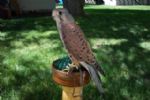Peregrine Falcons for Sale
No Peregrine falcons currently listed for placement
Peregrine Falcons
The Peregrine Falcon (Falco peregrinus), also known simply as the Peregrine, and historically as the "Duck Hawk" in North America, is a cosmopolitan bird of prey in the family Falconidae. It is a large, crow-sized falcon, with a blue-gray back, barred white underparts, and a black head and "moustache". It has the ability to reach speeds over 322 km/h (200 mph), making it the fastest animal in the world. As with other bird-eating raptors, the female is bigger than the male. Authorities recognize 17-19 subspecies, which vary in appearance and range; there is disagreement over whether the distinctive Barbary Falcon is a subspecies or a distinct species.
The Peregrine's breeding range includes land regions from the Arctic tundra to the Tropics. It can be found nearly everywhere on Earth, excepting extreme polar regions, very high mountains, and most tropical rainforests; the only major ice-free landmass from which it is entirely absent is New Zealand. This makes it the world's most widespread bird of prey. Both the English and scientific names of this species mean "wandering falcon", referring to the migratory habits of many northern populations.
While its diet consists almost exclusively of medium-sized birds, the Peregrine will occasionally hunt small mammals, small reptiles or even insects. It reaches sexual maturity at one year, and mates for life. It nests in a scrape, normally on cliff edges or, in recent times on tall man-made structures. The Peregrine Falcon became an endangered species due to the use of pesticides, especially DDT. Since the ban on DDT from the beginning of the 1970s onwards, the populations recovered, supported by large scale protection of nesting places and releases to the wild
The Peregrine Falcon has a body length of 34-50 cm (13-20 in) and a wingspan of around 80-120 cm (31-47 in). The male and female have similar markings and plumage, but as in many birds of prey the Peregrine Falcon displays marked reverse sexual dimorphism in size, with the female measuring up to 30 percent larger than the male. Males weigh 440-750 g, and the noticeably larger females weigh 910-1500 g; for variation in weight between subspecies, see under that section below.
The back and the long, pointed wings of the adult are usually bluish black to slate gray with indistinct darker barring; the wingtips are black. The underparts are white to rusty and barred with thin clean bands of dark brown or black. The tail, colored like the back but with thin clean bars, is long, narrow and rounded at the end with a black tip and a white band at the very end. The top of the head and a "mustache" along the cheeks are black, contrasting sharply with the pale sides of the neck and white throat. The cere is yellow, as are the feet, and the beak and claws are black. The upper beak is notched near the tip, an adaptation which enables falcons to kill prey by severing the spinal column at the neck. The immature bird is much browner with streaked, rather than barred, underparts, and has a pale bluish cere.
Pictures of Peregrine falcons
Upload your picture

Eppy - educational Peregrine Falcon

Peales Peregrine bred by GREAT PLAINS PEALES

 Eppy - educational Peregrine Falcon
Eppy - educational Peregrine Falcon Peales Peregrine bred by GREAT PLAINS PEALES
Peales Peregrine bred by GREAT PLAINS PEALES